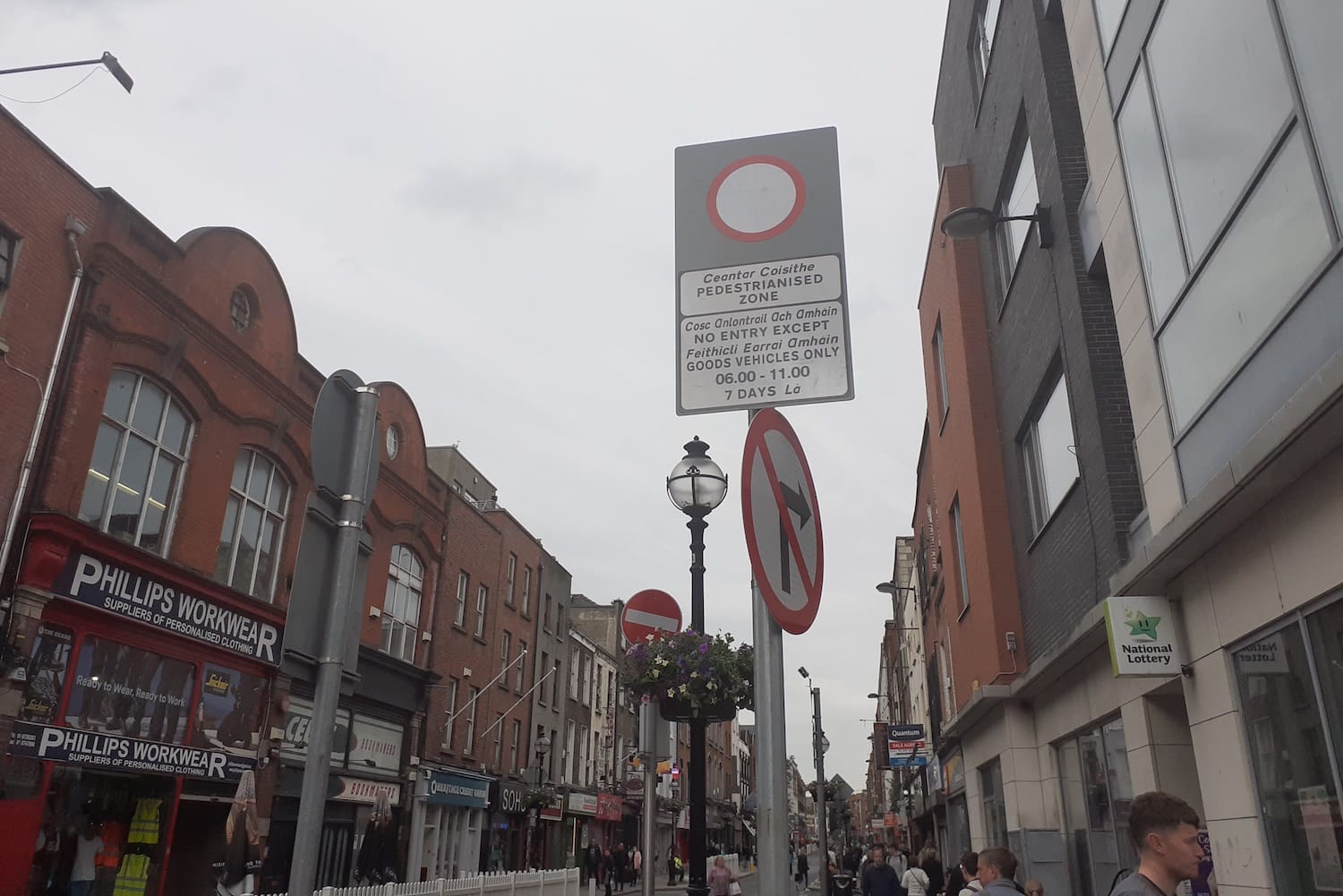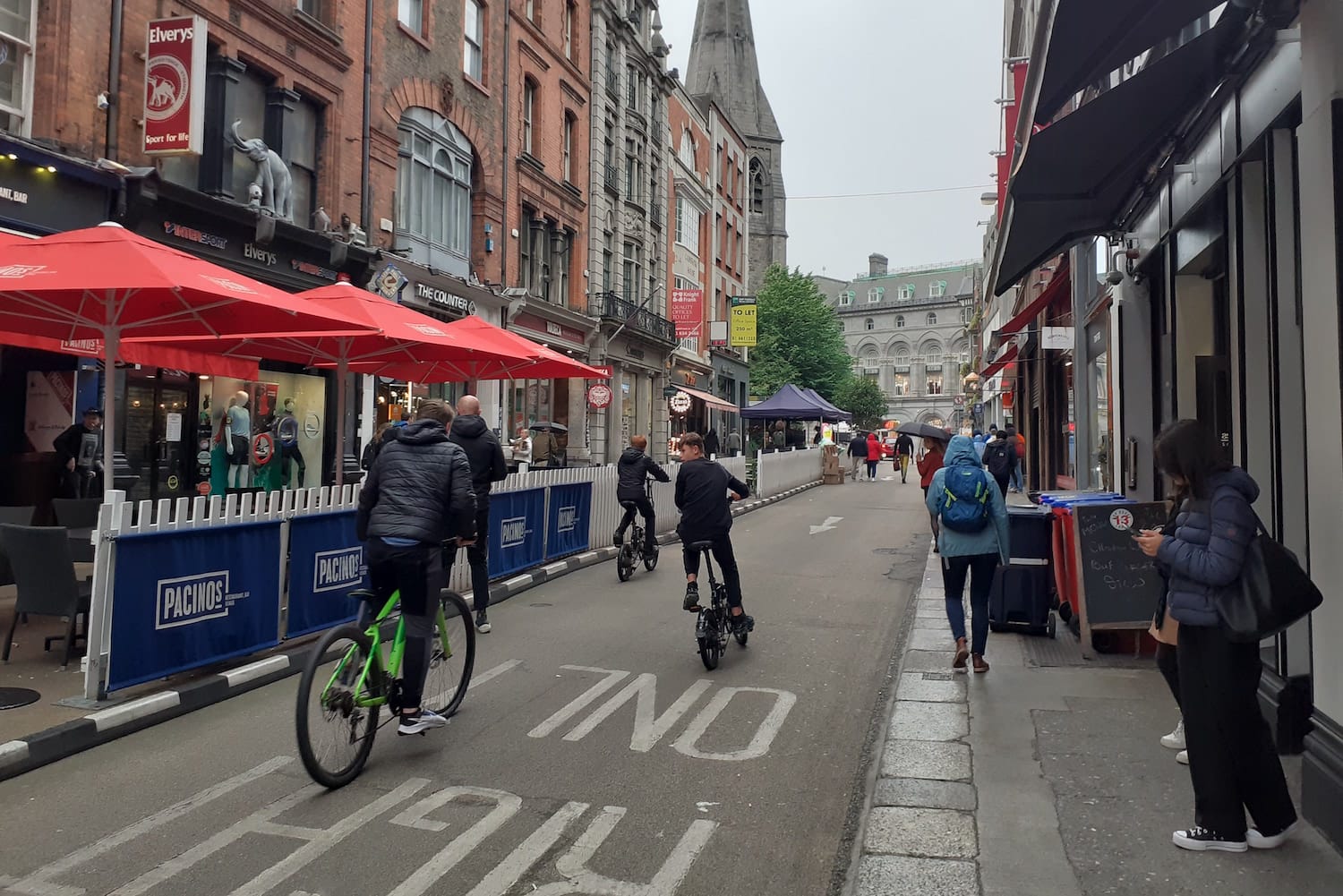Nobody caught illegally dumping yet by new north inner-city CCTV
But the scheme is a success, said a council official's report, as that shows the cameras are a deterrent.
Some locals want to see a cycle lane put in the entire way, while others say they are grand with a more free-form, free-flowing approach.

On Friday, Conal Daly is sitting on a bench outside Brother Hubbard eating a sandwich.
When he’s cycled to Capel Street recently, he’s sailed up the centre of the road, no cars to bother with, he says.
Capel Street was officially made a traffic-free street by Dublin City Council on 20 May, after 89 percent of respondents to a public consultation said they were in favour.
Daly says he likes the changes but thinks the street layout isn’t quite finished yet.
Cyclists and scooters travel back and forth at varying speeds. Some pedestrians choose to walk on the road, but others stick to the footpaths.
There’s nothing telling cyclists to slow down, he says. “Just to be safe around pedestrians.”
So far the council has opened up Capel Street so that pedestrians can mix with cyclists and e-scooters. But in the future, it may explore contra-flow cycling, its proposals say.
Shoppers on Capel Street on Friday, and local councillors, have their own suggestions on how the street should look going forward with some backing segregated cycle lanes and others arguing cyclists should have to dismount.
It isn’t unusual for traffic-free streets in the city to be shared by both pedestrians and cyclists.
That’s the case with Suffolk Street in the city centre and on Grangegorman Road Upper.
In the news, the changes to Capel Street were sometimes described as pedestrianised. A sign next to Spar on Capel Street says the area is a “Pedestrianised Zone” except for delivery times between 6am and 11am.
But that’s not the experience of pedestrians on the street, says Lynn Hooper, from Sherrard Street Pride of Place.
It has been unclear to her and others whether Capel Street is pedestrianised or traffic-free, she says. “Where my mam lives, there’s a lot of old folks, and they go down Capel Street with their walkers.”
“The electric scooters, the electric bikes. They’re flying up and down,” she says. “If they want people to walk on the road, there’s no safety in it.”
It’s important that people know what the road is being used for, says Rachel Lee, a policy and research manager for Living Streets, a UK charity that advocates for streets focused around cyclists and pedestrians.
“If people expect it to be pedestrianised and they walk out into the road and they’re almost run over by a bike, they’re gonna feel annoyed and worried and scared,” says Lee.

Hooper says she’d like to see pictures of bikes on the tarmac so that people know to expect bikes using the street.
On Capel Street on Friday, pedestrians voiced mixed feelings around the potential for conflict with cyclists. “I cycle everywhere,” says Mary Burnham, as she browses one of Capel Street’s charity-shop windows.
“The only thing is some cyclists are awful in that they speed and they don’t stop for people. So they can be very disruptive,” she says.
Barbara Fitzgerald, holding her granddaughter’s hand, says she doesn’t mind the bikes really. “If people are careful, I don’t think it’s a problem.”
If Capel Street’s design is to be revisited, suggestions from councillors and those wandering the street on Friday generally fall within two camps: put in a segregated cycle lane or ban the bicycles.
Joe Costello, a Labour Party councillor, says that if something bad happens between a cyclist and a pedestrian on Capel Street, it may harm efforts to pedestrianise other streets.
“We’ve had to fight very hard to get them pedestrianised,” he said. “If we turn them into effectively a cycle lane-type street, I don’t think we’re going to make much progress in pedestrianising streets.”

Cyclists can easily dismount, he says, so they should do that rather than staying on what can be a fast-moving vehicle.
Burnham also says the best option might be to not allow them on the road at all, as with Grafton Street or Henry Street. Although speed bumps for cyclists or a cycle lane are other options, she says.
Green Party Councillor Janet Horner says that Capel Street is a key north–south route. People using bikes and scooters should still be able to take advantage of that, she says, while making it harder for those in motor vehicles.
“We want it to be that bit more difficult, and disincentive people from taking their cars,” she says.
On South William Street, cars exiting Brown Thomas Car Park can still use the street, but bollards closing the street off to Exchequer Street traffic has made the road safer, Horner says.
“The city centre in general is much better, safer, etc, for limited the number of cars using it,” she says. “By having, like, low-car streets, low-traffic streets, is still a much much more safe and pleasant ambience for people walking.”
On Friday, as he wheels his bike toward Bolton Street, Umar Ali says his job as a Deliveroo rider is smoother now. “It’s very easy for us to go using this street.”
There should be more segregation between cyclists and pedestrians, says Curtis Currens, standing by the AIB Bank. “Because if it leaves it open, there’s just too much opportunity for an accident to happen.”
Hooper, from Sherrard Street Pride of Place, also suggests marking sections off with white lines, like on greenways. “If there was something like that, saying this is a bike lane and this is the walk lane, it would work.”
Pedestrians on the street force you to slow down, says Ali, the Deliveroo rider. “When the people are in front of us, I am riding the bike very slowly. Because I don’t want to hurt anybody.”
But it could be better if there was a cycle lane, he says, so as to prevent any clashes. “There is a lot of space for walking people. But there is no track for the riders,” says Ali.
A speed limit sign of 5 km/h might help, says Daly, sitting on the bench on the side of the street.
“You don’t want a courier going through at 30 miles an hour trying to get from A to B, and there’s a couple of kids having lunch,” he says.
Lee, the policy and research manager for Living Streets, says that it can be unsafe to mix pedestrians and bikes if there isn’t a additional, separate safe space for pedestrians
“Because there’s still pavements there, you’ve still got a safe space for blind, anyone with sight loss, to walk on the footway,” she says. A kerb means guide dogs won’t direct anyone off the footpath.
On Capel Street, if people don’t feel safe sharing the space with bikes, they can use the footpaths, says Horner. “If safe space is provided, people will use it.”
Lee says there needs to be a pedestrian crossing for them too, she says. “What if they want to get to a shop on the other side?”
Horner says that making more streets traffic-free might help the cycling culture in Dublin to mellow a little.
It might be strange for cyclists to move from a car-centric environment on an adjoining road, to a pedestrian-centric one on Capel Street, she says.
“This is a different vibe, and they have to slow down and they have to think about things and they have to change up their speed,” she says.